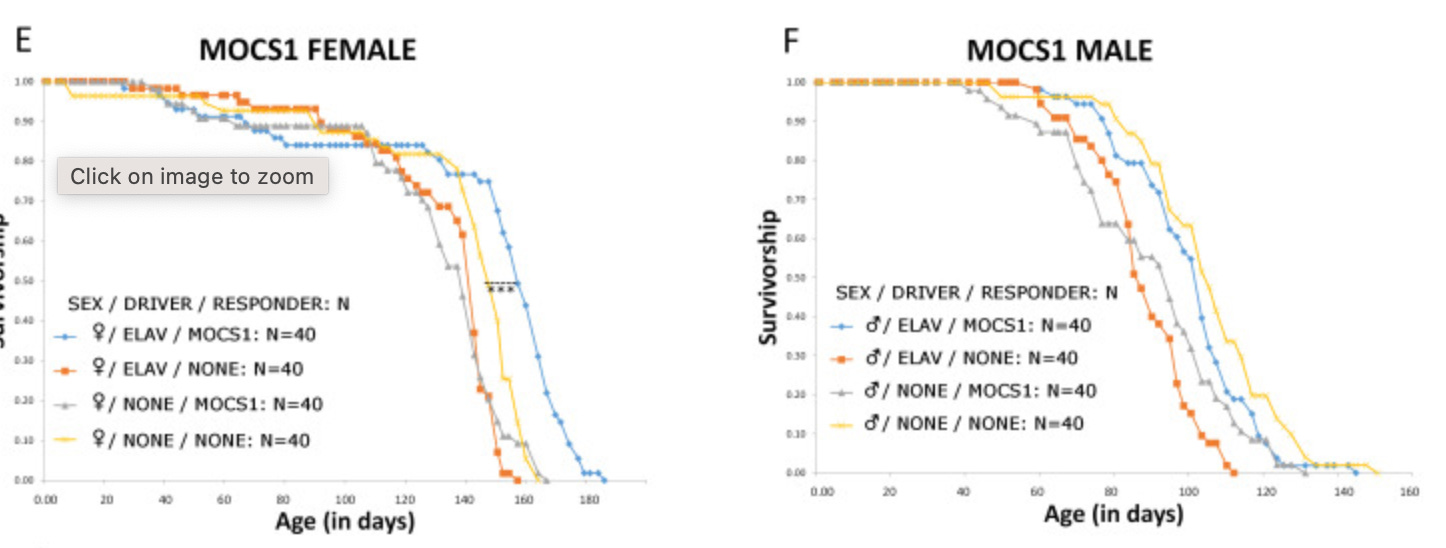Chris Masterjohn has put another email out about Molybdenum which I copy below.
Forwarded this email? Subscribe here for more
Here are some hints that it may.
Chris Masterjohn, PhD
Mar 1 



 READ IN APP
READ IN APP
In order to be useful, molybdenum has to be incorporated into the molybdenum cofactor (“MoCo”) protein.
The first two enzymes involved in the synthesis of MoCo are coded for by the gene MOCS1.
Researchers were investigating an mTOR (or just “TOR” in this case)-related aging hypothesis in the fruit fly Drosophila and accidentally stumbled their way into the finding that increasing MOCS1 lengthens lifespan in females. The MOCS1 gene was being unintentionally influenced in their original experiment, so they repeated the experiment in a controlled manner to investigate the role of MOCS1.
Because fruit flies mainly express MOCS1 in the nervous system, and because the brain may regulate lifespan in response to nutrient sensing, they engineered the flies to specifically over-express this enzyme in their neurons.
The degree to which increasing MOCS1 expression lengthened lifespan is signified by the degree to which the blue line in the graphs separates itself to the right of the other lines:

It had no effect in males, but it lengthened lifespan 6-12% in females.
The sex-specific effect is largely a mystery, but it makes sense that females have higher molybenum requirements than males, because estrogen increases hydrogen sulfide production.
Fruit flies don’t have “estrogen” but they have estrogen-like hormones, and regardless of whether the mechanisms are the same, females have much higher expression of the first one or two (depending on the strain) enzymes of involved in converting homocysteine to hydrogen sulfide.
That doesn’t necessarily mean that female fruit flies have a higher sulfite burden than males, but it would enable it, and that would make female fruit flies similar to female humans, who experience greater sulfite production during estrogen peaks of monthly cycles, when using birth control or plan B, when pregnant, or when using HRT.
This also can be easily reconciled to a whole other body of evidence that restriction of the sulfur amino acid methionine lengthen lifespan in fruit flies and rodents. The major paradigm for interpreting this is that S-adenosyl-methionine (SAMe) activates the mammalian target of rapamycin (mTOR), so restricting methionine reduces mTOR’s role in aging. However, glycine supplementation activates mTOR and lengthens lifespan. Genetic evidence favors the hypothesis that glycine lengthens lifespan through glycine N-methyltransferase (GNMT), which absorbs extra methyl groups from SAMe, and, when everything needed from proper buffering capacity is in place, allows them to be scavenged in between meals so that the methyl group supply stays relatively stable.
Rapamycin is the namesake of mTOR, and it inhibits MTOR and lengthens lifespan in mice. However, it also scars their hearts, raises their glucose, fattens their liver, and shrinks their testicles.
These findings are usually not witnessed in glycine/methionine studies, and usually these outcomes are improved rather than hurt in those studies. (Although methionine restriction does lead to fatty liver in the context of simultaneous choline restriction and the addition of sugar, alcohol, or fat).
While I will not argue the mechanisms involved could be many and varied, I will point out that the trans-sulfuration pathway is strongly activated by SAMe, and SAMe will rise far more pronouncedly if glycine and GNMT are not serving as a buffer. Thus, an excessive ratio of methionine to glycine (read how to balance them here) should lead to more sulfite accumulation, and thus a higher molybdenum requirement.
Thus, ALL of the above evidence can be reconciled in a model where sulfite — which is toxic across the board, destroys thiamin and B6, tanks testosterone, destroys sperm, drives the nausea, vomiting, and even in many cases hallucinations of pregnancy — also shortens lifespan, which implies that meeting the requirement of molybdenum to convert that sulfite to sulfate should be a critical component in everyone’s longevity toolbox.
While women most likely require more molybdenum than men, men are no less vulnerable to sulfite toxicity and should be no less concerned about meeting their molybdenum requirement.
I have several resources on meeting your personal molybdenum requirement: the Molybdenum Vitamins and Minerals 101 lesson, A Simple DIY Home Test for Molybdenum Deficiency, and Missing From the Databases: Molybdenum, which covers how to get enough molybdenum from food.

